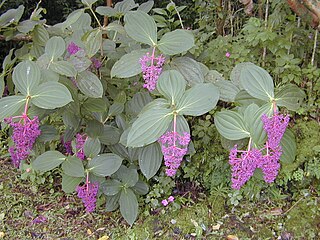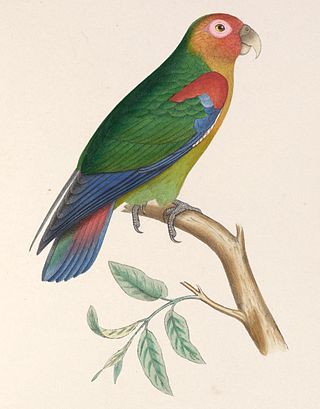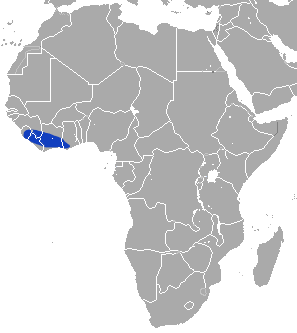
The dark chanting goshawk is a bird of prey in the family Accipitridae which is found across much of sub-Saharan Africa and southern Arabia, with an isolated and declining population in southern Morocco.

Medinilla is a genus of about 400 species of flowering plants in the family Melastomataceae, native to tropical regions of the Old World from Africa east through Madagascar and southern Asia to the western Pacific Ocean islands. The genus was named after J. de Medinilla, governor of the Mariana Islands in 1820.

The Afghan snowfinch or the Afghan ground-sparrow, bar-tailed snowfinch, Meinertzhagen'ssnowfinch, or Theresa's snowfinch, is a passerine bird of the sparrow family Passeridae, endemic to the northern parts of the Hindu Kush mountains in Afghanistan. There are no major threats to the species despite its restricted range, so it is assessed as least concern on the IUCN Red List. This species is mostly a seed-eater, supplementing its diet with some insects. It builds its nest in the burrows or hollows of ground-dwelling rodents, lined with hair or feathers.

The rusty-faced parrot is a Near Threatened species of bird in subfamily Arinae of the family Psittacidae, the African and New World parrots. It is found in Colombia and Venezuela and possibly Ecuador.

The streaked scrub warbler, also known simply as the scrub warbler, is a small passerine bird. It is the only species placed in the genus Scotocerca. It is found in northern Africa and south-western Asia. It is a bird of desert fringes, frequenting scrubby areas, ravines and gorges, and is mainly resident, although local movements can occur outside the breeding season.

Therese's shrew is a species of mammal in the family Soricidae. It is found in Ivory Coast, Ghana, Guinea, Liberia, and Sierra Leone. Its natural habitats are subtropical or tropical moist lowland forest and moist savanna.

Quekettia is a small genus of orchids classified in the subtribe Oncidiinae. This genus is found in the humid lowlands of Brazil, the Guianas, Venezuela, Ecuador and Trinidad.
Tanganya virus(TGNV) is an enveloped, single-stranded, negative-sense RNA virus, possibly of the genus orthohantavirus in the Bunyavirales order. It is the second indigenous Murinae-associated African hantavirus to be discovered. It has a low sequence similarity to other hantaviruses and serologically distinct from other hantaviruses. Its host is Crocidura theresae.

Falsomesosella is a genus of longhorn beetles of the subfamily Lamiinae, containing the following species:

Pterolophia is a genus of longhorn beetles of the subfamily Lamiinae, containing the following species:
Ropica theresae is a species of beetle in the family Cerambycidae. It was described by Pic in 1944.
Cassinia theresae is a species of flowering plant in the family Asteraceae and is endemic to central New South Wales. It is an erect shrub with hairy young stems, needle-shaped leaves with flared bases, and corymbs of up to fifty flower heads.
Eunidia theresae is a species of beetle in the family Cerambycidae. It was described by Stephan von Breuning in 1939.
Falsomesosella theresae is a species of beetle in the family Cerambycidae. It was described by Maurice Pic in 1945.
Pterolophia instabilis is a species of beetle in the family Cerambycidae. It was described by Per Olof Christopher Aurivillius in 1922. It is known from Seychelles.
Pterolophia guineensis is a species of beetle in the family Cerambycidae. It was described by James Thomson in 1864, originally under the genus Alyattes.
Mallosia theresae is a species of beetle in the family Cerambycidae. It was described by Maurice Pic in 1900. It is endemic to Turkey.
Medinilla theresae is an endemic species of flowering evergreen shrub or liana in the family Melastomataceae, occurring on ultramafic soils on the dwarf forests of Mt. Redondo, Dinagat Island at 700-840 elevation, and at Mt. Hamiguitan, Philippines at growing at 900 m elevation on the edges of upper montane forest, which reaches up to the 'mossy-pygmy' forest with elevation ranges of 1160−1200 m and 1460−1600 m elevation, respectively. This terrestrial, cauliflorous shrub can grow erect at 1.5 m high. The species whorled leaves, flowers which are 4-merous, and the pendulous inflorescences likened the species to M. pendula. However, it differed from the latter on distinct secondary veins on the leaves adaxial surface, the inflorescences which are cauline or axillary, and its straight anthers.
Laevipilina theresae is a species of monoplacophoran, a superficially limpet-like marine mollusk. It is known from a live specimen collected in the Eastern Weddell Sea of Antarctica.








